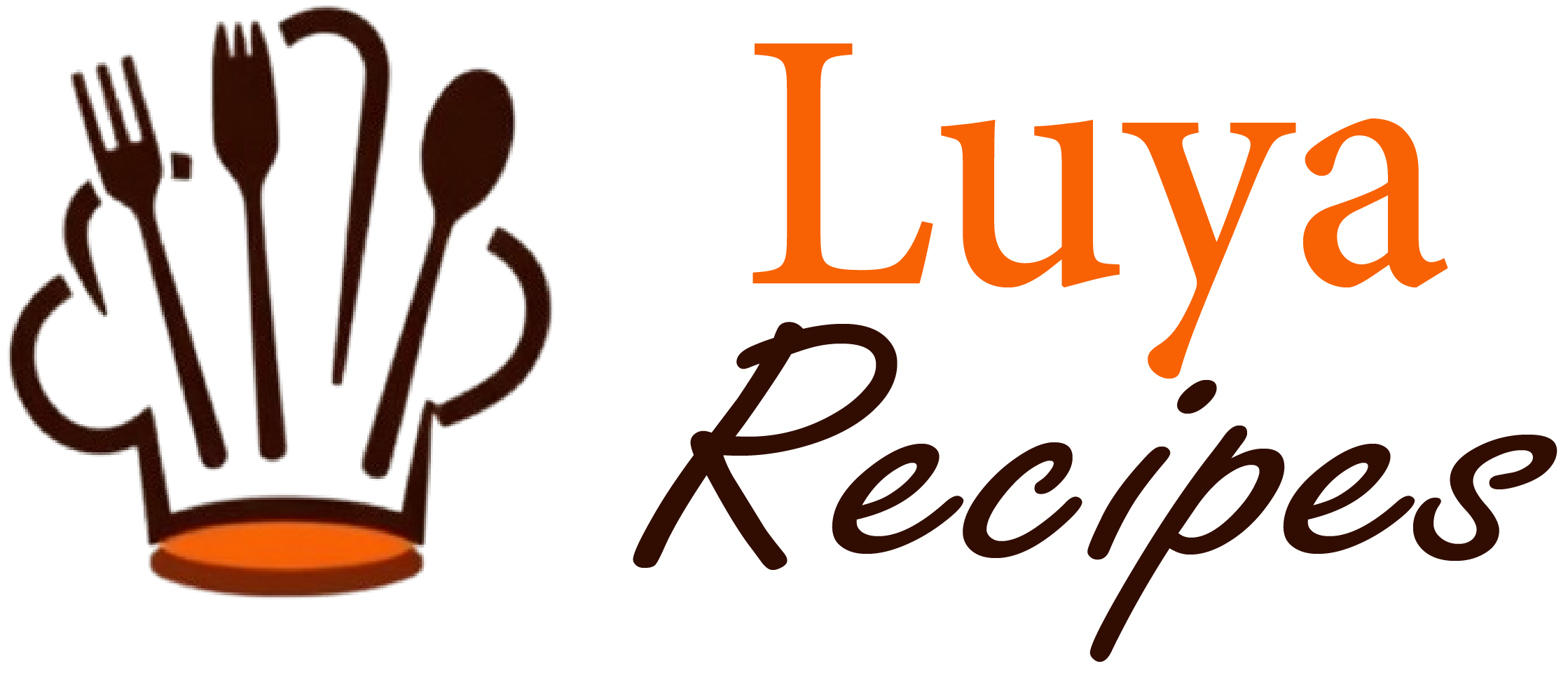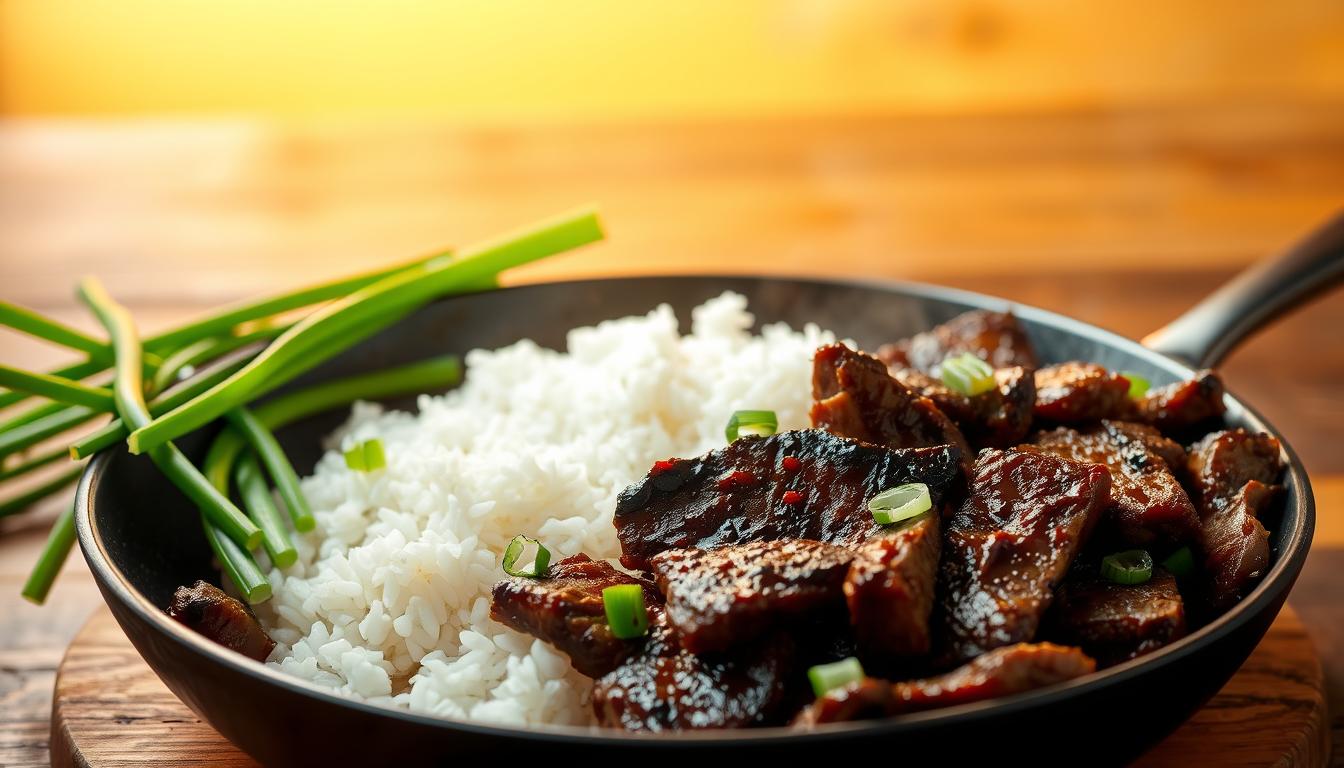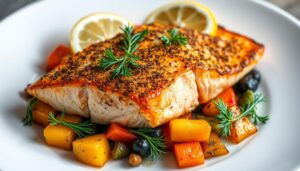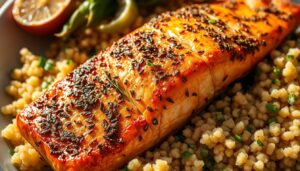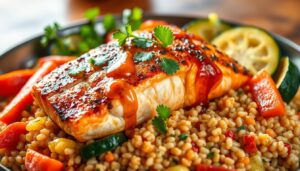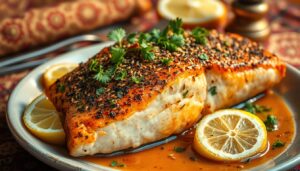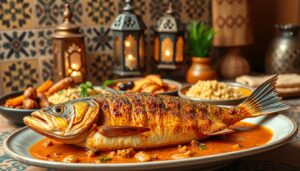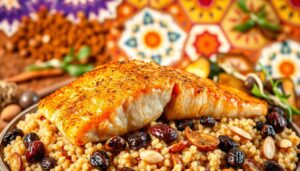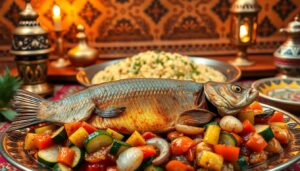Discover the culinary magic of bo luc lac, a Vietnamese shaking beef recipe that transforms simple ingredients into an extraordinary dining experience. This iconic dish from Vietnam’s rich gastronomic tradition captures the essence of bold flavors and precise cooking techniques.
Originating from the bustling streets of Saigon, bo luc lac has become a global sensation. Food enthusiasts worldwide have fallen in love with this vibrant dish that combines tender beef, aromatic marinades, and an unmistakable cooking method that gives it its unique name.
At luyarecipes.com, we’re passionate about bringing authentic Vietnamese cuisine directly to your kitchen. Our bo luc lac recipe promises to transport your taste buds to the heart of Vietnam with every single bite.
Key Takeaways
- Bo luc lac is a traditional Vietnamese beef dish with rich cultural roots
- The recipe requires specific marinating and cooking techniques
- Authentic ingredients are crucial for capturing genuine Vietnamese flavors
- The “shaking” technique is key to creating perfect bo luc lac
- This dish offers a perfect balance of texture and taste
Understanding Bo Luc Lac: Vietnamese Shaking Beef Origins
Beef luc lac represents a culinary treasure deeply rooted in Vietnamese gastronomy. This vibrant shaking beef stir fry offers more than just a delicious meal – it tells a story of cultural heritage and cooking innovation.
Vietnamese cuisine celebrates bold flavors and unique cooking techniques. The origins of bo luc lac trace back to Saigon’s bustling street food scene, where skilled chefs developed innovative ways to prepare tender beef dishes.
Cultural Significance in Vietnamese Cuisine
Shaking beef stir fry is not just a recipe but a symbol of Vietnamese culinary artistry. Traditionally prepared for special occasions, beef luc lac demonstrates the intricate balance of textures and flavors that define Vietnamese cooking.
“Every shake of the wok tells a story of generations of culinary expertise.” – Chef Mai Nguyen
Why It’s Called “Shaking Beef”
The name “shaking beef” comes from the unique cooking method. Chefs vigorously shake the beef in a hot wok, creating a rhythmic motion that ensures even cooking and caramelization. This technique helps develop rich, complex flavors characteristic of authentic Vietnamese cuisine.
Regional Variations Across Vietnam
Different regions in Vietnam prepare beef luc lac with subtle variations. Southern regions tend to use more robust marinades, while northern areas might incorporate lighter seasonings. Each approach reflects local ingredients and cooking traditions.
Essential Ingredients for Perfect Bo Luc Lac Recipe
Creating an authentic bo luc lac requires carefully selected ingredients that bring Vietnamese cuisine’s vibrant flavors to life. Your journey starts with choosing premium beef cuts – typically tenderloin or sirloin work best for this traditional dish. The quality of meat dramatically impacts the final taste and texture of your shaking beef.
The heart of bo luc lac ingredients lies in the magical luc lac marinade. You’ll need soy sauce, garlic, sugar, and black pepper as core components. Fresh ingredients like minced garlic and crushed black pepper elevate the marinade’s complexity. Oyster sauce adds depth and a subtle sweetness that distinguishes this Vietnamese delicacy.
“Great bo luc lac is about balancing flavors and respecting traditional techniques.” – Vietnamese Culinary Expert
For an authentic preparation, gather additional ingredients like fresh lime juice, salt, and a touch of rice vinegar. Green onions and fresh cilantro will provide bright, herbaceous notes. Red onions sliced thinly make an excellent garnish that complements the rich marinated beef.
When sourcing your bo luc lac ingredients, prioritize freshness. Local Asian markets often stock specialized items like premium oyster sauce and authentic Vietnamese condiments. If unavailable locally, reputable online specialty stores can help you acquire these essential components for your luc lac marinade.
Kitchen Tools and Equipment You’ll Need
Preparing delicious vietnamese grilled beef requires the right kitchen tools and equipment. Whether you’re a home cook or a culinary enthusiast, having the proper gear can make a significant difference in your Bo Luc Lac preparation.
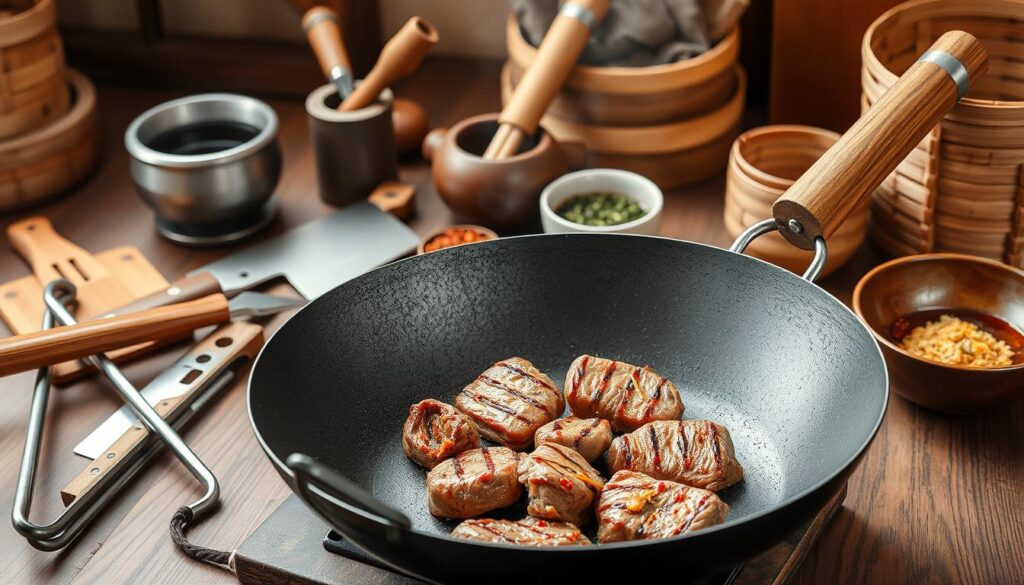
Professional chefs and home cooks alike understand that quality equipment transforms ordinary vietnamese grilled beef into an extraordinary culinary experience. The right tools can help you achieve authentic flavors and perfect texture.
Traditional vs Modern Cooking Methods
Traditional Vietnamese cooking methods rely on classic cast-iron woks and open flame cooking. Modern techniques incorporate non-stick pans and electric stoves. Both approaches can produce delicious results when you understand the nuances of heat control and ingredient preparation.
Wok Selection Tips
“The secret to great vietnamese grilled beef is in the pan!” – Chef Mai Nguyen
When selecting a wok, consider carbon steel or cast-iron options. These materials distribute heat evenly and create the perfect sear for your beef. Look for a flat-bottomed wok if you’re using an electric stove, and a round-bottomed version for gas ranges.
Additional Kitchen Essentials
Essential tools include a sharp chef’s knife, meat tenderizer, reliable meat thermometer, and sturdy cooking tongs. A good cutting board and marinading container will also elevate your vietnamese grilled beef preparation.
Selecting and Preparing the Perfect Cut of Beef
Choosing the right beef cut is crucial for creating an authentic shaking beef recipe. Traditional Vietnamese cuisine typically uses tenderloin or sirloin for bo luc lac. These cuts provide the most tender and flavorful meat for your dish.
When selecting beef for your shaking beef recipe, look for high-quality meat with minimal fat marbling. Aim for cuts that are about 1-inch thick to ensure even cooking and maximum tenderness. Prime or choice grade beef works best for achieving restaurant-quality results.
“The secret to an amazing shaking beef recipe is in the meat selection and preparation.” – Vietnamese Culinary Expert
Trimming the beef is an essential step in preparation. Remove any excess fat or tough connective tissue. Cut the meat against the grain into uniform 1-inch cubes. This technique ensures each bite is tender and cooks evenly during the quick stir-frying process.
Pro tip: If tenderloin is too expensive, consider using sirloin or ribeye as budget-friendly alternatives. The key is to slice the meat thinly and uniformly for the perfect shaking beef recipe.
The Secret Behind the Perfect Luc Lac Marinade
Creating an authentic bo luc lac recipe starts with mastering the luc lac marinade. This magical blend of ingredients transforms ordinary beef into a spectacular Vietnamese dish that will tantalize your taste buds.
The secret to an exceptional luc lac marinade lies in balancing flavors. Your marinade should combine salty, sweet, and umami elements that penetrate the beef deeply.
Essential Marinade Components
Key ingredients for your bo luc lac recipe include fish sauce, garlic, soy sauce, and a touch of sugar. Each component plays a crucial role in developing rich, complex flavors that define traditional Vietnamese shaking beef.
“A great marinade is the heart of any bo luc lac recipe” – Vietnamese Culinary Experts
Optimal Marinating Techniques
Timing is critical when marinating beef. For the best results, let your meat sit in the luc lac marinade for 30 minutes to 2 hours. This allows the flavors to fully penetrate without breaking down the meat’s texture.
Smart Marinade Storage
You can prepare your marinade up to 3 days in advance. Store it in an airtight container in the refrigerator. Always discard marinade that has been in contact with raw meat to prevent bacterial growth.
Step-by-Step Vietnamese Shaking Beef Preparation
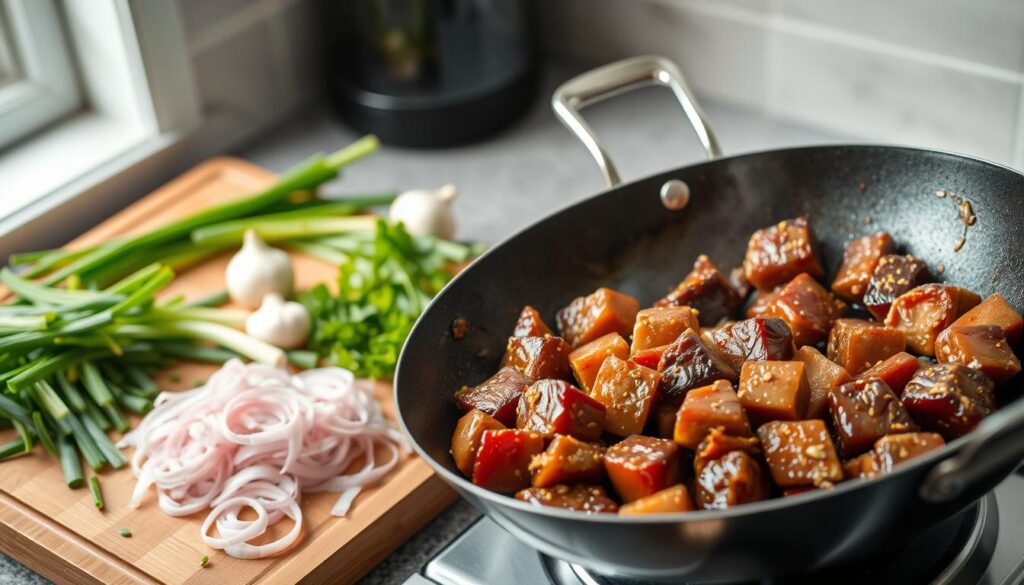
Preparing authentic vietnamese shaking beef requires precision and careful technique. Start by removing your marinated beef from the refrigerator about 30 minutes before cooking to ensure even temperature distribution. Pat the beef cubes dry with paper towels to help achieve that perfect golden-brown sear during your shaking beef stir fry.
Heat a heavy-bottomed wok or cast-iron skillet over high heat. Add a splash of vegetable oil and wait until it’s smoking hot. This high temperature is crucial for creating the signature caramelized exterior of traditional vietnamese shaking beef.
“The key to perfect shaking beef is quick, high-heat cooking and constant movement.”
Carefully add your beef cubes in a single layer, ensuring they’re not overcrowded. Let them sear for 30-45 seconds without moving, then begin the signature “shaking” technique. Gently shake and toss the beef to ensure even cooking on all sides. This method creates a delicious, crispy exterior while keeping the inside tender and juicy.
Cook the beef for 2-3 minutes total, or until it reaches your desired doneness. Remove immediately from heat and let rest for a minute before serving. The result should be a beautifully caramelized, restaurant-quality shaking beef stir fry that captures the essence of Vietnamese cuisine.
Mastering the Shaking Technique
The shaking beef recipe requires a special cooking method that transforms ordinary beef into an extraordinary Vietnamese delicacy. Mastering this technique means understanding the delicate balance between heat, movement, and timing.
When preparing your shaking beef recipe, the wok becomes your primary tool for creating perfect seared meat. The key lies in rapid, controlled movements that seal in flavor while creating a beautiful caramelized exterior.
Traditional Cooking Method
Your shaking technique starts with high heat and a well-seasoned wok. Move the beef quickly, using a side-to-side motion that allows each piece to contact the hot surface briefly. This method ensures each bite of shaking beef receives an even, delicious sear.
“The secret is in the shake – not too slow, not too fast.” – Vietnamese Cooking Master
Common Mistakes to Avoid
Many home cooks struggle with the shaking beef recipe by overcrowding the pan or using low heat. Keep your beef pieces separated, use high heat, and shake consistently. Overcooking will toughen the meat, destroying the tender texture that makes this dish special.
Practice makes perfect with this unique cooking technique. Your shaking beef will improve with each attempt, bringing you closer to an authentic Vietnamese culinary experience.
Accompaniments and Side Dish Suggestions
Your beef luc lac deserves the perfect companions to elevate its rich flavor profile. Traditional Vietnamese cuisine offers several delightful side dishes that complement this delectable lemongrass beef stir fry. White jasmine rice remains the classic base, providing a neutral backdrop that allows the beef’s robust taste to shine.
“The right side dish can transform a good meal into an unforgettable culinary experience.” – Vietnamese Culinary Tradition
Consider pairing your beef luc lac with fresh cucumber salad or pickled vegetables. These crisp accompaniments cut through the meat’s richness and add a refreshing contrast. Steamed vegetables like bok choy or water spinach also work wonderfully, bringing nutritional balance to your plate.
For those seeking a more adventurous approach, try serving lemongrass beef stir fry alongside garlic-sautéed morning glory or a tangy green papaya salad. These options introduce exciting textures and flavors that complement the beef’s savory notes. A small dish of lime-based dipping sauce can further enhance your dining experience.
Experiment with different combinations to discover your perfect beef luc lac meal. Each side dish brings its unique character, turning a simple recipe into a memorable Vietnamese culinary journey.
Plating and Presentation Tips for Restaurant-Style Results
Transforming your vietnamese grilled beef into a restaurant-worthy dish is all about presentation. The right plating technique can elevate your bo luc lac from home cooking to a gourmet experience that delights both the eyes and the palate.
Start by selecting a clean, white ceramic plate that provides a crisp background for your vietnamese grilled beef. The contrast will make your dish pop and showcase the rich colors of the meat and garnishes.
Elegant Garnishing Techniques
Garnishing is an art that can transform your bo luc lac. Sprinkle fresh chopped cilantro or mint leaves around the edge of the plate. Thinly sliced red chilies add a vibrant splash of color and hint at the dish’s spicy potential.
“Presentation is the final touch that turns a good meal into an unforgettable dining experience.” – Chef Mai Nguyen
Masterful Sauce Placement
When serving vietnamese grilled beef, sauce placement is crucial. Create an artistic drizzle of dipping sauce on one side of the plate, or use a small ramekin positioned at an angle. This allows diners to control their sauce intake while maintaining a professional look.
Remember, your goal is to create a visual feast that matches the incredible flavors of bo luc lac. With these simple techniques, you’ll bring restaurant-quality presentation to your home kitchen.
Wine Pairing and Serving Suggestions
Elevating your bo luc lac recipe goes beyond perfect cooking techniques. The right beverage can transform your Vietnamese shaking beef dining experience into a culinary adventure. Wine selection plays a crucial role in complementing the rich umami flavors of this traditional dish.
“A great wine pairing can turn a good meal into an unforgettable dining experience.”
Red wines work brilliantly with bo luc lac. Look for medium-bodied options like Pinot Noir or Grenache. These wines offer enough complexity to match the beef’s robust flavor without overpowering the delicate marinade. Californian Pinot Noirs provide an excellent balance with their fruit-forward profile.
For those preferring white wines, a crisp Riesling can cut through the richness of the bo luc lac recipe. The wine’s slight acidity helps refresh your palate between bites. Vietnamese beer like Saigon or 333 also makes an authentic accompaniment that connects directly to the dish’s cultural roots.
Serving temperature matters. Keep red wines around 60-65°F and whites chilled at 45-50°F. Serve your bo luc lac on warm plates to maintain optimal temperature and enhance the overall dining experience.
Conclusion
Mastering bo luc lac or Vietnamese shaking beef is more than just following a recipe—it’s about embracing a culinary tradition that connects you with Vietnamese culture. By understanding the nuanced techniques and ingredients, you’ve unlocked a gateway to creating restaurant-quality dishes right in your kitchen.
The art of vietnamese shaking beef lies in its simplicity and precision. From selecting premium beef cuts to perfecting the signature shaking technique, each step represents a blend of skill and passion. Your willingness to experiment with marinades, cooking methods, and presentation will transform an ordinary meal into an extraordinary dining experience.
Luyarecipes.com remains committed to bringing authentic Vietnamese recipes directly to your home. We invite you to explore more culinary adventures, share your bo luc lac creations, and continue expanding your cooking repertoire. Remember, great cooking is about passion, practice, and the joy of discovering new flavors.
Whether you’re a seasoned home cook or a curious beginner, your journey with Vietnamese shaking beef starts here. Embrace the process, trust your instincts, and most importantly, enjoy every delicious moment.
FAQ
What does “Bo Luc Lac” mean?
Bo Luc Lac literally translates to “shaking beef” in Vietnamese, referring to the unique cooking technique where the beef is shaken in a hot wok during the stir-frying process.
What cut of beef is best for Bo Luc Lac?
Traditionally, tenderloin or filet mignon are the preferred cuts for Bo Luc Lac. These tender cuts ensure a soft, melt-in-your-mouth texture that is characteristic of authentic Vietnamese shaking beef.
How long should I marinate the beef?
For optimal flavor, marinate the beef for 30 minutes to 2 hours. Avoid marinating longer than 2 hours, as the acid in the marinade can break down the meat’s texture and make it tough.
Is Bo Luc Lac spicy?
The traditional recipe is not typically very spicy. However, you can adjust the heat level by adding fresh chili peppers or red pepper flakes to suit your taste preferences.
What side dishes pair well with Bo Luc Lac?
Bo Luc Lac is traditionally served with steamed white rice, watercress salad, and a simple dipping sauce made with lime juice, salt, and pepper. Some also enjoy it with pickled vegetables for added flavor and texture.
Can I make Bo Luc Lac without a wok?
Yes, you can prepare Bo Luc Lac using a large skillet or cast-iron pan. The key is to use high heat and keep the beef moving to achieve the characteristic sear and “shaking” technique.
Is Bo Luc Lac gluten-free?
The traditional recipe can be gluten-free, but you’ll need to use gluten-free soy sauce or tamari to ensure the marinade meets gluten-free requirements.
How do I know when the beef is cooked perfectly?
For medium-rare, cook the beef for about 2-3 minutes total, ensuring a nice sear on the outside while maintaining a pink center. Use a meat thermometer if you’re unsure, aiming for an internal temperature of 135°F (57°C).
Can I use a different type of meat?
While beef is traditional, you can experiment with chicken or tofu as alternative proteins. Just adjust the cooking time accordingly to ensure proper doneness.
How should I store leftover Bo Luc Lac?
Store leftover Bo Luc Lac in an airtight container in the refrigerator for up to 3 days. Reheat gently in a pan to prevent overcooking and maintain the meat’s tenderness.
